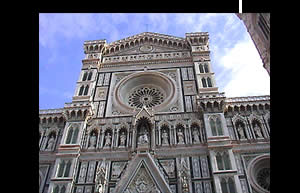|
Italian Art
From
the outstanding Byzantine mosaics in the churches of Ravenna
to the Greek temples of Sicily and Roman amphitheatres in
a number of cities, Italian art in all its forms of expression
magically spans the passing of the centuries, from the Roman
Empire to the present day, in a continual succession of visual
surprises for visitors to enjoy.Italy is the land of Donatello,
Tintoretto, Titian and Giorgione, all
painters of extraordinary calibre who produced vast quantities
of works.
In
the School of Cimabue trained the painter Giotto,
the most important artist of the XIVth cent. whose works include
the Bell Tower in Florence and the frescoes in the Upper Basilica
of St. Francis in Assisi. Princes of the XVth and XVIth cents.
commissioned painters, sculptors and architects to beautify
their residences and towns. This practice was copied also
by the Papal State where both Raphael and Michelangelo
worked during the first half of the XVIth cent.. Michelangelo
was a sculptor ( La Pietà, Basilica of St. Peter’s),
an architect ( Dome of St. Peter’s) and a painter (the
Sistine Chapel). Renaissance painting, just like the literature
of the time, drew on themes from classical mythology: in the
painting of The Birth of Venus ( c. 1485, The Uffizi
Gallery, Florence), Botticelli portrays the Goddess
of Love newly risen out of the sea.
Gian
Lorenzo Bernini was the greatest interpreter of Baroque
style. He was an architect, a painter, a stage designer and
a comedy writer but above all he was a very great sculptor.
His artistic training was completed in Rome, where he worked
all his life as official artist of the Popes and for the most
significant noble families in Rome. His artistic production
was exceptionally immense and varied, the fruit of a theatrically
oriented fusion of architecture, sculpture and painting. His
most renowned sculptures include the Apollo and Daphne
(1622-24) housed in the Gallery of the Villa Borghese in Rome,
and the Ecstasy of St. Theresa (1644-51) in the Church
of Santa Maria della Vittoria in Rome. For over fifty years
Bernini was engaged in the task of enlarging and decorating
the Basilica of St. Peter’s, for which he created the
square with the colonnaded wings (1657-65), the Baldacchino,
or Canopy, (1624-33), the Chair of St. Peter (1656-66) and
the tombs of two different Popes. He adorned Rome’s most
important squares with monumental fountains, including the
very beautiful Fountain of the Four Rivers (1648-51)
in Piazza Navona.
In
the XVIIIth cent. Canaletto regaled posterity with
his slendid views of Venice and scenes of Venetian life bathed
in a light and true-to-life atmosphere. This century saw the
return of classical idealsi, in literature and in art, stimulated
also by the great many ongoing archaeological excavations,
for example at Herculaneum and Pompei: Antonio Canova
(Cupid and Psyche, 1787-93, Gipsoteca di Possagno,
Treviso) was without a doubt the greatest interpreter of Neoclassicism
in sculpture.
XXth cent. Italian art produced a number of highly original
and diverse talents, for example from the Futurist School,
Boccioni, Balla, Carrà, or later,
Giorgio De Chirico, Renato Guttuso and Alberto
Burri. The latter (1915-1995) used commonplace materials
in his works, such as sacking, plastic and tar; the artist
attacked his materials with fire burns and gaping lacerations.
The material themselves are the content in their own right:
they do not symbolise anything but rather are suggestive of
the states of mind, suffering and torment that are deeply
rooted in Man and his existence.
home
|
|











